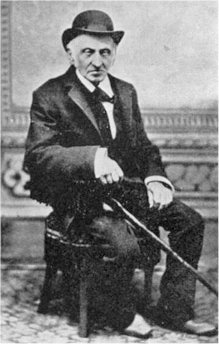
In 1869, German-Jewish immigrant Louis Rose developed a settlement in what is known today as Point Loma. “Roseville is a lovely spot of land that is beginning to assume an importance and attention worthy of the citizens of San Diego,” noted the San Diego Union in April that year. Little could Rose know then the value and legacy of his land venture.
Members of Point Loma Assembly and La Playa Trail Association will commemorate the 150th anniversary of Roseville with dinner and a lecture on Tuesday, Feb. 12, from 5:30 to 7 p.m. The public is invited, with a suggested donation of $10 at the door at Point Loma Assembly, 3035 Talbot St. For dinner, RSVP to Klonie Kunzel at 619-222-1950.
Author, historian, and Rose expert Donald H. Harrison will present a history lecture to honor San Diego’s first Jewish settler and his Roseville enterprise. “In 1989, we started the Old Town Trolley,” Harrison says. “I was researching tour information as first general manager and kept running into the name Louis Rose: Rose Creek, Rose Canyon, Roseville, Robinson-Rose House. So I began to collect tidbits.” In 2005, Harrison published a meaty biography on the early pioneer, aptly titled, “Louis Rose.”
Harrison is current editor and publisher of the daily online San Diego Jewish World. He served as editor-in-chief of the award-winning San Diego Jewish Press-Heritage and columnist for San Diego Jewish Times.
While Louis Rose was busy buying land along the bay near the tired port at La Playa, Alonzo Horton was buying property in spacious downtown San Diego, and the Kimball Brothers to the south in National City. They were competitors, but worked cooperatively to encourage city growth. When Rose arrived in 1850, the settled population of Old Town was simply 650, not counting native Americans, and boom was slow. “Located between Old Town and San Diego’s bay entrance, Rose saw Roseville as the most perfect port to unload ships onto a transcontinental railroad, which he had hoped to attract to San Diego,” Harrison says. “Those dreams were not realized. The terminus was laid at Los Angeles.”
According to the book “Louis Rose,” Roseville was laid out in grid fashion, with all streets being 75 feet wide except Main Street measuring 100 feet wide. Main Street eventually became Rosecrans Street. (Incidentally, there is no name connection to Louis Rose; the street was named for Civil War general and California Congressman William S. Rosecrans after his death in 1898. And they call Pasadena the City of Roses!).
Roseville was 30 blocks long and eight blocks wide. Streets were named 1st through 30th. Avenida de Portugal would have been called 1st Street. Harrison says that Rose had a lot of lots to give away. He was eager to get people to settle there. Rose deeded some of his lots to women – married, widowed, and divorced. Harrison says: “My best guess is that as a divorcee, Rose may have enjoyed some dinners in the homes of these women. I think in making out the deed to the women of the households, he showed himself to be an early feminist. In those days men usually held title to properties.”
Eventually Louis Rose remarried and he and previously widowed Mathilde raised a daughter. A second daughter died in infancy.
The settlement of Roseville was created over barren land. Today, the community blends into the larger populace of Point Loma. You may traverse Roseville unaware as you shop and work along Rosecrans Street. Hats off to the “Old World immigrant Louis Rose who helped shape the politics, planning, and development of our region.” Louis Rose Point A plaque and small circle of land alongside the boat channel at the foot of Womble Street were dedicated “Louis Rose Point” in 2005 to honor Rose’s dream to move the City from Old Town to the edge of San Diego Bay. For more information about Roseville, visit the rotunda of Point Loma/Hervey Branch Library for La Playa Trail Association’s Roseville exhibit that runs March through April. Members of Point Loma Assembly and La Playa Trail Association will commemorate the 150th anniversary of Roseville with dinner and a lecture on Tuesday, Feb. 12, from 5:30 to 7 p.m. The public is invited, with a suggested donation of $10 at the door at Point Loma Assembly, 3035 Talbot Street.
For dinner, please RSVP to Klonie Kunzel at 619 222-1950.












Discussion about this post